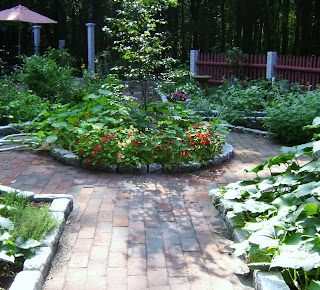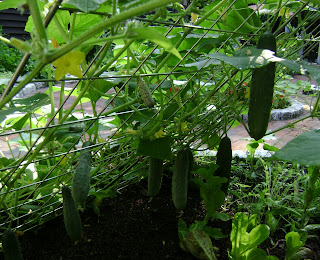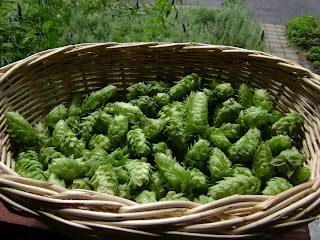So I'm not very good at blogging. I think of all sorts of things to write about, but never actually sit down and do it. So I'll keep trying and see if I can get into the swing of this!
A customer who is planning her herb garden contacted me recently looking for a listing of herb companion planting. No problem I thought, I have lots of information on companion planting. But in looking at it more closely, I realized all the information I had related to companion planting with vegetables and I really didn't have anything that specifically addressed herbs.
Intrigued, I decided to make up my own. What a good winter project, that turned out to be more difficult than it sounds. There really wasn't a lot of good information in my own personal herb book library or on the internet, so I picked out what I could and then headed to the library at Tower Hill Botanic Garden. I went through all kinds of herb books, and developed my own list.
So what is companion planting? Simply speaking, it is putting plants together that benefit each other or keeping those apart that don't. Mother Nature does this on her own but we can mimic it in our own gardens. Companion planting sets up a kind of large scale symbiosis between the plants in your garden, and can do everything from provide insect control, climbing support, control competition, and provide soil conditioning. Some plants even release chemicals that are helpful to other plants, or on the other hand, toxic to other plants.
Going a little further, companion planting also includes not planting together plants that are susceptible to the same insects or diseases and putting together plants that like the same growing conditions but occupy different soil strata. For example, planting African marigolds and narcissus together. The bulbs are planted deep so the marigolds can be planted on top and the marigold repels nematodes that attack the bulb.
According to Anna Carr in Good Neighbors: Companion Planting for Gardeners, companion planting is a mix of folk wisdom, fairy tale or scientific proof, usually a little of all three.
I found this all fascinating. If you would like to read further about companion planting, some books I like are Herbs in the Garden, The Art of Intermingling by Rob Proctor and David Macke, Roses Love Garlic, Secrets of Companion Planting with Flowers by Louise Riotte (which has a great list of herbs as they related to insect control), and Good Neighbors: Companion Planting for Gardeners by Anna Carr.
And I will continue working on my list so if you have any good herbal companion planting thoughts, please pass them along!
So here's the list of things to plant together with their dislikes and other information such as pest control. I included vegetable information as well because if you're like me, I interplant my vegetables and herbs together so find this helpful.
Angelica: Nettle. Dislikes Dill
Anise: Cilantro -plant together for faster germination
Basil: Marigold, Parsley, Tomatoes. Dislikes Rue. Deters flies, mosquitoes, aphids, white fly, controls tomato worm (1 basil plant to 3 tomato plants)
Bergamot (Monarda/Bee Balm): Attracts honey bees
Borage: Tomatoes, Squash, Strawberries, said to increase strawberry crop. Controls tomato worm. Adds potassium, calcium & minerals to soil.
Caraway: Avoid Dill, fennel, carrot. Plant throughout the garden to loosen the soil.
Catnip: Eggplant, collards. Deters flea beetle, ants, attracts bees
Chamomile: Mint, Roses. Plant cabbages & onions to improve chamomile flavor. Improves health of plants grown close to it.
Comfrey: Strawberries. Rich in potassium, nitrogen & phosphates. Great in compost/compost tea
Cilantro (Coriander): Anise, Chervil, Dill (plant with Anise for faster germination). Deters aphids
Chervil: Cilantro, Dill, Anise. Deters aphids, attracts bees .
Chives: Parsley, Roses, Tomato, Carrots. Deters aphids, black spot on roses
Dead Nettle: Potatoes. Deters potato bug
Dill: Dislikes Lavender, Fennel, Caraway, Angelica. Dill & Fennel can cross-pollinate, attracts honey bees
Fennel: Most plants dislike this herb, don’t grow in vegetable garden. Deters fleas.
Feverfew: Roses, attracts aphids away from roses
Flax: Carrots,Potatoes. Deters Potato Bug
Garlic: Roses, raspberries, tomato, fruit trees. Deters Japanese beetle, aphids
Horehound: Tomatoe, horseradish. Deters potato bug, blister beetle
Henbit: General insect repellent
Hyssop: Cabbage, grapes, collards, broccoli, brussel sprouts. Dislikes radishes. Deters cabbage moth
Lamb Quarters: Marigolds, pansies. Deters Leaf miner, attracts lady beetle. Soil improver.
Lavender: Deters Moths -- combine with southernwood, wormwood and rosemary in an anti-moth sachet
Lemon Balm: Most plants, improves tomatoes, attracts nees
Lovage: Improves health & flavor of most plants near it. Dislikes rhubarb.
Marjoram: Sage, Nettle, Pepper. Repels most insects, attracts bees
Marigolds: Plant throughout the garden. Deters Mexican bean beetles, nematodes, others
Mint: Chamomile, Salad Burnet, Nettle, Tomato, Cabbage. Dislikes parsley. Deters white cabbage moth, aphids, flea beetles ants, mosquitoes, mice
Nasturium: Marigold, Savory, Cucumber. Deters cucumber beetle (sow in cucumber hills when plant)
Nettle: Mint, Sage, Marjoram, Angelica, Valerian. Deters Slugs, Snails
Oregano: Cabbage, cucumber, grapes. Deters Cucumber beetle, cabbage butterfly
Parsley: Chives, Roses, Onion, Tomato. Dislikes Mint. Deters Rose beetles, carrot flies, asparagus beetles
Pennyroyal: Roses, broccoli, cabbage. Deters ants, flies, fleas, mosquitoes. Helps roses, attracts bees.
Roses: Tansy, Rue, Pennyroyal, Parsley, Garlic, Chives, Chamomile. Dislikes Boxwood.
Rosemary: Sage, Collards, Cabbage. Deters cabbage moth, bean beetles, carrot fly
Rue: Roses, Strawberries, Raspberries. Dislikes Basil, Sage. Deters flies, Japanese beetles, dogs & cats
Sage: Rosemary, Nettle. Dislikes Rue & Onions.
Salad Burnet: Mint, Thyme
Savory: Onion, beans
Tansy: Roses, Raspberries, Squash. Dislikes Collards. Good all-round insect repellant. Concentrates potassium in soil.
Tarragon: All purpose beneficial garden helper
Thyme: Hyssop, Salad Burnet, Lettuce, Cabbage family. Deters cabbage maggots & worms, flea beetles. Said to help sick plants recover.
Valerian: Nettle. Stimulates phosphorous activity in soil, good for compost. Attracts earthworms.
Wormwood: Dislikes most vegetables. Deters Black flea beetles, mosquitoes, most animals
Yarrow: Aromatic herbs. Increases essential oil content & aromatic quality

 ad of garlic, and planted individually. Each clove will become its own plant and develop a head of garlic. I take the papery wrapping off the garlic clove, but others don't so you can experiment with that. The cloves are planted pointed end up. Make sure to mark where you planted your garlic, and after the ground has frozen put a thick layer of mulch over the area and wait for Spring.
ad of garlic, and planted individually. Each clove will become its own plant and develop a head of garlic. I take the papery wrapping off the garlic clove, but others don't so you can experiment with that. The cloves are planted pointed end up. Make sure to mark where you planted your garlic, and after the ground has frozen put a thick layer of mulch over the area and wait for Spring. s will appear and can use a good side dressing of compost or high nitrogen fertilizer. I like to fertilize through the season with a seaweed emulsion. And make sure to keep the area well weeded.
s will appear and can use a good side dressing of compost or high nitrogen fertilizer. I like to fertilize through the season with a seaweed emulsion. And make sure to keep the area well weeded.



































